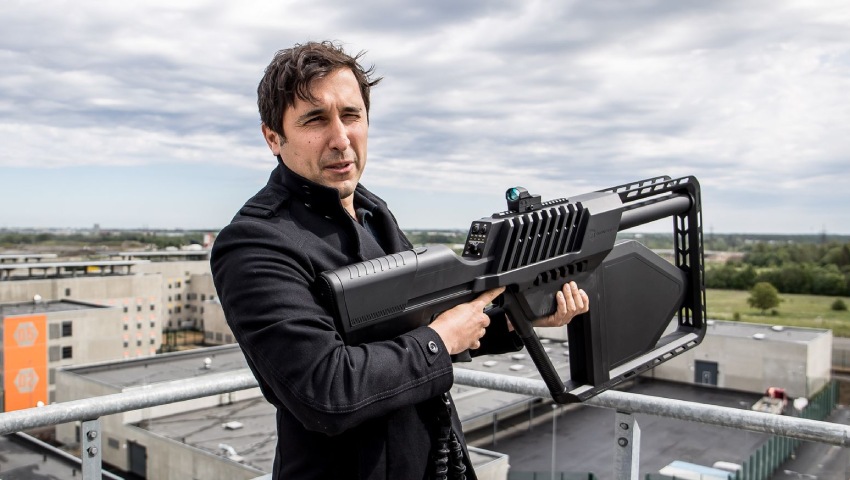The success of counter-UAS (C-UAS) defences often depends on a single factor: the ability of a human operator to correctly identify and react to a drone threat, writes Oleg Vornik, chief executive of DroneShield.
To continue reading the rest of this article, please log in.
Create free account to get unlimited news articles and more!
When the threat is a single drone or two, a C-UAS operator has a reasonable chance of assessing sensor data and choosing the appropriate response – whether hard-kill or soft-kill – in time to prevent the incoming UAS from accomplishing their mission.
But what if the threat is a dozen drones, or even a hundred? What if the attack is a co-ordinated strike by air, ground and naval unmanned vehicles? Drone swarms are becoming a reality that can saturate and overtax even the most well-trained human operator.
What is needed is technology that can both relieve the workload on human C-UAS operators, and assist them in quickly and reliably choosing the optimum response to deal with a drone threat.
One solution is to utilise the power of artificial intelligence (AI) for C-UAS. For example, operators face the problem of distinguishing real from false detections. Sounding the alarm too soon disrupts operations and wears out the defenders, but sounding it too late allows hostile drones to reach their targets unhindered. Compounding the problem is that many drones are controlled over the same ISM radio bands that are used by routers and other home electronics. This can be especially troublesome in cluttered urban environments with numerous radio-frequency (RF) sources.
However, AI can accurately identify which drones are using specific communications channels and protocols, which can be a difficult task when dealing with frequency-hopping models, or when encountering multiple drones of the same model.
AI is also hardware-agnostic, which allows it easily process data from a wide variety of domains, including radar, optical imagery and across the RF spectrum. Because most C-UAS development work is in software rather than hardware, AI has the flexibility to work with hardware extensions across a wide variety of missions.
Perhaps the biggest advantage of AI-based C-UAS is its inherent flexibility. Drone technology rapidly evolves, and therefore C-UAS must quickly evolve as well. The situation is similar to cyber security, where computer viruses constantly mutate into new forms, creating “zero day” surprises. Just as the anti-virus software on your computer must recognise new threats, a C-UAS system must be capable of dealing with unexpected threats.
AI has that flexibility because it does not rely on an exact match of the threat to a set library. Machine learning enables AI to pattern-match for recognition of new threats, and to evolve its algorithms in response to new conditions. And because AI is built into the system, the software doesn’t need to connect to the cloud for processing, which avoids the vulnerability of network disruption.
Sophisticated AI also enables C-UAS systems to provide support across multiple missions, from counterinsurgency and asymmetric warfare, to operations against advanced near-peer competitors. AI-based systems can be body-worn, mounted on vehicles and ships, or installed on fixed sites.
But to utilize the full potential of AI, the right hardware must be used. One problem with current C-UAS systems is that they often rely on CPU-based processors that are basically off-the-shelf technology designed for other uses before being repurposed. A better alternative is Field Programmable Gate Arrays (FGPA), a powerful but lightweight solution for the massive parallel processing that taxes CPU- and GPU-based systems. By parallelizing computations, FGPA allows the development of algorithms that are much faster than with CPU technology.
In addition, FGPAs are easy to reprogram, allowing C-UAS systems to be customised in response to changing threats and environments. Their smaller size and weight also enables development of lighter and more portable C-UAS systems.
The threat posed by drones will only grow over time. Unmanned vehicles are proliferating not just across advanced militaries, but also across smaller nations and insurgent groups who see drones as a cheap but effective way to wage asymmetrical warfare against more advanced foes.
Any nation that cannot defend itself against drones is vulnerable. Thus C-UAS has become an indispensable component of national security. But C-UAS is only effective if it can cope with a wide variety of ever-changing threats.
AI can help defeat those threats.
Oleg Vornik is CEO of DroneShield, Australian manufacturer of C-UAS systems.

 Login
Login







